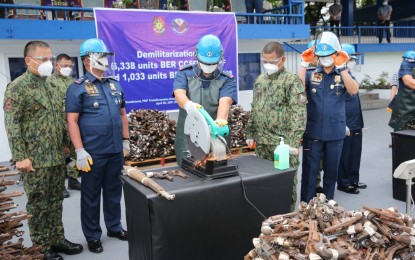
DESTROYED. PNP chief Gen. Debold Sinas (2nd from right) and other police officials lead the destruction of 7,371 beyond economical repair (BER) firearms in Camp Crame, Quezon City on Monday (April 26, 2021). Out of this number, 6,338 are beyond economical repair (BER) weapons that were confiscated or surrendered to the police force while the remaining 1,033 are BER weapons of the PNP. (Photo courtesy of PNP Public Information Office)
MANILA – The Philippine National Police (PNP) on Monday destroyed a total of 7,371 dilapidated firearms in Camp Crame, Quezon City.
PNP chief Gen. Debold Sinas witnessed the event which was a brainchild of the Directorate for Logistics and PNP National Headquarters Disposal Committee.
Out of this number, 6,338 are beyond economical repair (BER) weapons that were confiscated or surrendered to the police force while the remaining 1,033 are BER weapons of the PNP.
Under PNP Memorandum Circular No. 2017-017, the destruction of BER firearms, explosives and ammunition is an allowable method of disposal for unsaleable PNP property as it may pose a hazard to the public if not destroyed.
"This ceremonial disposal of defective firearms and ammunition demonstrates a clear method of proper procedure in the destruction of unserviceable firearms, and discarded ordnance in order to avoid the occurrence of any untoward incident that may place someone else’s life in danger or at high risk," Sinas said.
He added that this procedure manifests the professional responsibility of the PNP to ensure that these weapons and instruments of violence will not find their way into the arsenal of criminal and terrorist groups.
The process involved cutting individual steel pieces into sections using a circular saw or blowtorch, bending and deform each piece, deforming hammer and trigger assembly using a blowtorch, grinder, or power tools, and cutting or chopping wooden parts and stamp aluminum parts.
The cut metal pieces from the discarded weapons are disposed of as recyclable scrap materials and maybe converted into farming tools and industrial equipment, according to Maj. Gen. Angelito Casimiro, PNP Director for Logistics. (PNA)
